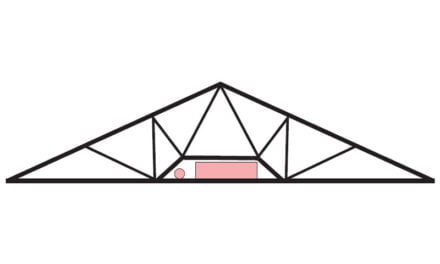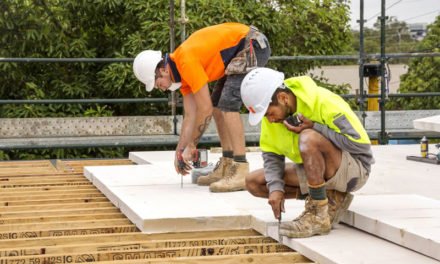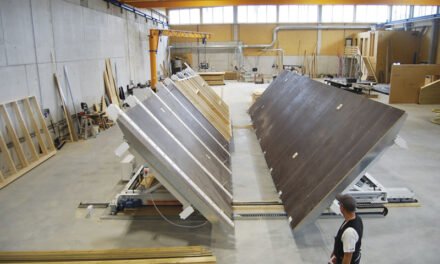Gerry McCaughey is a pioneer of modern offsite construction. In his talk to the Timber Offsite Construction audience, he delivered advice the industry should be heeding.
At the recent Timber Offsite Construction conference, Gerry McCaughey was the much-anticipated speaker for a talk titled The Future is Off-Site. One of the main proponents of FIOSS (fully integrated offsite solutions), McCaughey is the CEO of Entekra, having previously taken Century Homes (later Kingspan Century) from a small start-up with four employees to Europe’s largest FIOSS provider, dominating the market in both his native Ireland and the UK.
He opened by confessing that he loved talking about offsite construction. “It’s all I’ve ever known,” McCaughey said. “Not only have I been at it for 40 years, my family has been in offsite construction for close on 60 years. So, while to some people, it’s a relatively new thing, in my family it’s just the way we’ve always done it, as that famous expression in construction says.”
He had one quibble with the description of his speech, which highlighted the idea of ‘panelisation’. “I have to say you’ll probably find that I’m not a fan of that terminology,” said McCaughey. “And the reason why I’m not is because I don’t think people get the proper understanding of what it is that’s actually bringing the benefits to the builder if they focus on the panel. Hence why we call what we’re doing a fully integrated offsite solution.”
He recapped his and his family’s 60 years in offsite construction. The three different companies they’ve begun in that time are all still going, despite the traditional boom and bust cycles of construction and the fact they have invested heavily in automation. “Many people think that heavy investment is a risk, but what actually happens in many situations is that people don’t understand the business model they’re getting into.”
He warned against specialising in only single family, or multi-family or ADU (accessory dwelling unit/granny flat) construction: “With offsite construction, to make it successful in the long term, one thing you have to realise is you actually have to be very, very flexible.”
The expense of automation and the fact most automated plants have far more capacity for jobs than will be met by simply working in one type of construction means that, “If they put all their eggs in one basket and think they’re only going to do multi-family, say, because they’re big, large projects, that actually is the downfall because they’re very ‘lumpy’ in terms of production going through a manufacturing facility,” he said.
“And that doesn’t allow you to keep your assets sweating most of the time. So you have to be able to do ADUs, single family, multi-family, hospitality, hotels, nursing homes and other projects all at the same time.”
McCaughey touched on various methods of offsite construction such as panelised, volumetric and more before announcing they were the wrong place to focus: “I want to highlight that, in reality, 80% of the benefit that offsite construction brings to a builder is derived not from the building components or panels, but from the process improvement that is required to deliver those components to site, to build the building faster.”
He shared a slide of a house graphic, with 80% labelled as Process Improvement and the remaining 20% as Building Components.

“The components should be thought of as merely an output of a very detailed process. And it’s the process that’s delivering the benefits,” McCaughey said. “It’s going into that building, creating a 3D model, working out the problems, the clashes, doing the correct quantities, working out the logistics all up front before you ever go on a job site. Only 20% of the benefit is delivered by the actual panels when they arrive on site.
“The one thing about true offsite construction regardless of whether it’s modular or the advanced offsite panelised system that we use is: it’s a system. And it’s the system that brings the benefit.”
Quoting Aristotle’s ‘the whole is greater than the sum of the parts’, McCaughey outlined the differences between being able to offer a complete building system and being able to offer quality components. In the latter case, the builder is buying from multiple suppliers, which adds cost and worse, “nobody’s totally responsible, and nobody’s totally in control,” he said. “When you have that holistic view and somebody is responsible for the totality of that building, that’s what forces the efficiency into the process. FIOSS is a process, it’s not a product. We don’t think of it as selling a product to a builder, but as a massive change in the processes he uses to build the building.”
DESIGN TO BUILD
McCaughey broke down offsite construction into five different parts: design, engineering, offsite manufacturing, delivery or logistics, onsite assembly and finishing, flagging design as the most important.
“Everything we do derives from this: figuring out the problem that the builder is otherwise not going to figure out using any other system or any other process until he gets on site,” he said.
He described the process the Entekra team goes through during the design phase as building a “digital twin” of the building: “Everything comes from that 3D model. Because we have the building built twice, first on a computer screen and then later on a job site. And everybody can probably agree, it’s a hell of a lot cheaper to figure out a problem on the computer screen than it is to figure out when you’re standing on a job site with a crane, equipment and people and your costs are already running.”
Century Homes was one of the first companies to invest in a high level of 3D modelling, which was basically unheard of 30 years ago. “It allowed us to produce a quality of building and an efficiency that nobody could touch,” McCaughey said. “So it’s the most critical stage and the most collaborative stage of the whole process. It takes out that ‘not my job’ mentality. Because what we’re doing there is we’re bringing in all of the people who are connected to that building. If you touch off or you connect to that frame, then we need to have a discussion with you before we ever make that frame.
“That’s what I mean about changing the process, because in many cases this normally doesn’t happen until you’re on the job site.”
At Entekra, during the production of the model, Oculus virtual reality goggles are used to ‘walk’ through the frame model of the building. And it’s not just the architects and engineers. Everybody, including the plumber and the electrician, sees what is planned to happen in reality long before it gets to the job site, to spot any issues, from structural problems to conflicts for services to details like power points in inconvenient spots.
“Taking that time upfront to do that speeds up the process on site and saves thousands,” said McCaughey. “Particularly in multi-family buildings, we have on multiple occasions saved builders tens of thousands of dollars solving problems that would not have been found until they got onto the job site.
“This is the most critical part of the process. Once everyone signs off, that 3D model then sends the CAM files directly to the automated machinery. There’s no human input after that point.”
PRECISION TIMING
While there are lessons for all fabricators in what McCaughey has to say about upfront planning with partners, Entekra is at the leading edge when it comes to automation. A sophisticated factory management system makes decisions about what will be cut in what order and to what tolerances, and the saws and manufacturing equipment work directly off the 3D model.
The productivity generated by the machines is astonishing, McCaughey said: “Each CNC machine does five-and-a-half metres per second at a tolerance that could not be achieved by humans. It can make walls 12m long, plus or minus two millimetres – absolute and utter precision. So when you get onto a job site, you know it will go together.”
Just as important is the delivery or logistics. McCaughey knows it’s a tough environment to secure follow-on trades, his solution is to “make yourself the most attractive job site there is, so the trades want to go to you first.”
The first step here is simply treating workers and trades well. The second is helping them to make a profit. McCaughey does this by delivering a consistency of framing so that workers can both be more comfortable and more productive on site and also feel confident in their scheduling.
“Make sure that when you say to the trades, ‘This will be ready for you on Tuesday,’ it’s always ready on Tuesday,” he says. “That means they don’t have to turn their workers around to go somewhere else. They know that their workers are going to be fully utilised.
“They’ll want to come to your job site first, because they know they can make more money on your job site because your logistical planning is better than everybody else’s.”
He prides himself on the fact that at an Entekra job site, when the trucks pull up in the morning, it means 4000 square feet of that house will be up to plate level by five o’clock that afternoon. “No question. Happens every day, multiple times a day,” McCaughey said. “And we hear repeatedly from customers in California that the trades love working on the job sites with offsite construction, because of the ability they have to make more money and the predictability is second to none.”
Once on site, the assembly is the easy part. Essentially it’s a kit of parts that goes together using the very detailed drawings, no different to Lego or IKEA except in scale and detail. Everything from doorways and windows to ducting and cable paths are already cut and even the crane lifting points are attached to the panels.
“That happens as an output of everything else that takes place,” said McCaughey. “I think that’s where a lot of people who invest in this industry fail to understand where the money should go. We see people who’ve gone out to raise money to set up advanced automated factories, and they’ll invest millions in equipment then go and buy the cheapest piece of software that they can.
“In reality, the automation won’t do anything it’s not told to do. It’s the software that’s driving the automation, not the other way around, so, QED, software is more important than automation, because it’s what delivers the accuracy.”
Accordingly, Entekra invests nearly as much into design and engineering software to ensure they have the most efficient process for getting that data from the design engineer and other design stakeholders to the factory equipment.
BETTING ON DELIVERY
McCaughey concluded with a short video, showing a house being assembled to plate level in a single day. It was the first job done for a new Californian client, called Beazer Homes. The trades employed on that job were so impressed with the experience, they slightly lowered their fee for every house on the next offsite build for that builder.
“It’s about productivity and profitability,” said McCaughey, before describing another case study. This was the first, 272,000 square foot, phase of an apartment project with a builder who had not used offsite construction before. “He was very reluctant, and he had a good relationship with the stick framer who had built two previous apartment complexes with him. He said to us, your price is slightly more expensive than the stick framework and I don’t really know who you are.
“So we put our proposal to him: if we cut the cycle time to frame the building on site, is that worth anything to you? Obviously it was: he could get rental income faster, because it’d be completed faster. And he could convert it from his construction loan to his permanent loan faster, which is a significant difference in interest rate. Plus there was a significant reduction in waste.”
McCaughey offered to share the risks; they would do the job for the same price as the stick framer, the builder would calculate the financial benefit in completing the framing in 14 weeks instead of 42 and they’d split that benefit if Entekra made the deadline.
“Typically, that job would have required 100 framers on site,” McCaughey said. “We did it in 14 weeks with a total of 20 framers. We significantly reduced the amount of construction traffic and CO2 emissions on site, plus also reduced his workers comp liability insurance, because he had fewer people on site. There was no storage of materials required, which meant there was less pilferage and less risk of fire.
“I am very happy to report we split the money: $600,000. And we are now working on the second phase of his project.”
This isn’t the first builder to tell McCaughey that offsite is more expensive. “I always want to ask them, ‘are you telling me that every builder I have converted to stay with me over 42 years has decided to stay with me because they like spending more money building their projects?” he asked. “No, they don’t. They stay because of the offsite process.
“What you can’t do as a builder with offsite construction is overlay your stick framing process on top of our offsite process and think you’re going to deliver savings. It’s about process improvement. You need to change the way you do things. You need to bring in a collaborative approach at the very beginning, to bring the trades in early and have all the information done upfront. If you do that, and you follow the process through, offsite will always deliver savings to the builder.”











